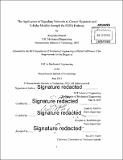The application of signaling networks to cancer metastasis and cellular motility through the EGFR pathway
Author(s)
Bharath, Ranjeetha
DownloadFull printable version (16.42Mb)
Other Contributors
Massachusetts Institute of Technology. Department of Mechanical Engineering.
Advisor
Linda G. Griffith and Douglas A. Lauffenburger.
Terms of use
Metadata
Show full item recordAbstract
This thesis explores the problem of cancer metastasis by analyzing the various downstream components of the epidermal growth factor receptor (EGFR) pathway. This work develops a mathematical model that consists of partial differential equations and signaling networks. Analysis techniques for these nonlinear reaction-diffusion equations included a study of the biological background and motivation, along with computational simulation of the various sets of models developed. The modeling effort combined biochemical reaction-diffusion equations for various species with mathematical descriptions of the mechanical machinery of the cell to characterize the foundations of cell movement in response to stimuli. By quantifying and qualifying the signaling networks and molecular pathways involved in cellular signaling and linking intracellular signaling to the mechanical machinery of the cell, it is possible to quickly check in silico the effects of changing various feedback parameters and signaling molecule concentrations. By creating a model of this process, it is possible to perform rapid tests of different pharmaceuticals on the biochemical and biomechanical pathways, in order to assess how they would affect cell motility and cancer metastasis on a large scale.
Description
Thesis: S.M., Massachusetts Institute of Technology, Department of Mechanical Engineering, 2015. Cataloged from PDF version of thesis. Includes bibliographical references (pages 83-86).
Date issued
2015Department
Massachusetts Institute of Technology. Department of Mechanical EngineeringPublisher
Massachusetts Institute of Technology
Keywords
Mechanical Engineering.